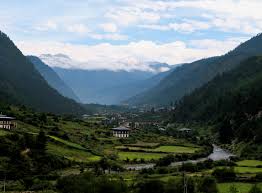
Haa Valley
Haa Valley : Adjoining the districts of Paro, Chhukha and Samtse, Haa valley is one of the most picturesque places in the Kingdom, spread over an area of 1706 sq. km. During pre-Buddhist era, Haa valley was known for its animist tradition. Inhabitants then were enthused in offering animal blood to their local deities.Such animist belief however was transformed into peaceful Buddhist tradition in 8th century by Guru Padmasambhava. The tantric master, Guru Padmasambhava, subdued the local deities like Ap Chundu and made the guardians of the Buddhist tradition. However, the traces of this belief system are still noticed in the form of festivals and rituals.
The Haa valley was opened for the first time to foreign tourists in 2002. It is culturally rich valley and some of famous sites in this region are : 7th century Lhakhang Karpo (White temple) and Lhakhang Nagpo (Black temple) at the foothills of a venerated three brotherly mountains known as Meri Puensum. The grand annual Haa Tshechu is also performed here at Lhakhang Karpo on the 8th-10th day of the 8th Bhutanese month.
The Haa Wangchuklo Dzong built in 1915 after the Dumchog Dzong was razed to the ground by fire is worth visiting. The other place of interest which involves some walking includes the hike to the 8th century Juneydrag, Katsho Goempa, Drana Trashidingkhag, Yangto Goempa, Jamtoe Goempa, Shelkardrag, Takchu Goempa and Haa Goempa.
The valley is also unparalleled in Bhutan in terms of the diversity of the folk culture, legends and shamanistic rituals. The shamanistic traditions is vividly practiced in almost all the communities, most notable of which is the annual ceremony to honour Ap Chundu, the guardian deity of the valley. The valley is also a paradise for nature lovers and travelling there is a very rewarding experience.
The drive to Haa valley crosses 3988m Chele-la pass, from where one can have a superb views of Mount. Chomolhari & Jichu Drakey. It is also an ideal place to take short walk, enjoying panoramic vistas.

Post Discussion